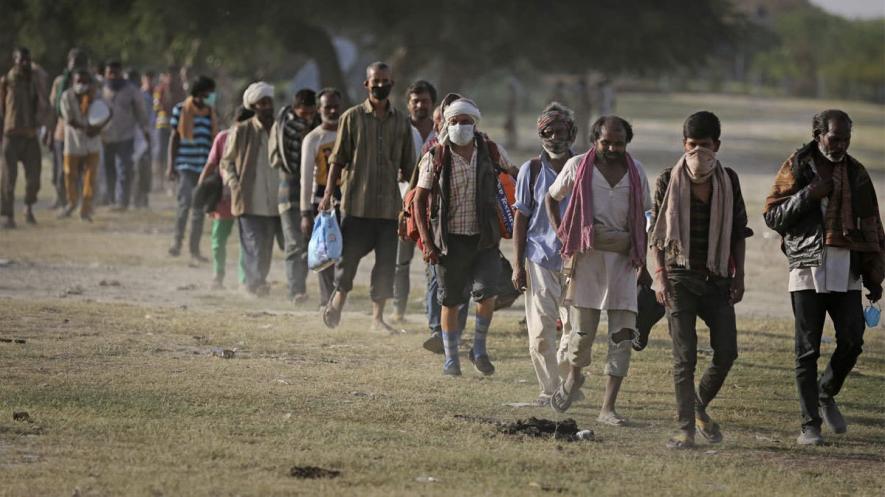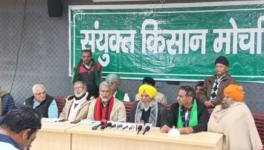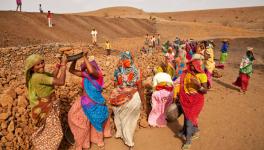COVID-19 in Rural India - XL: Impact on Rural Workforce in Bihar’s Bharri, An Update

Representational image. | Image Courtesy: Economic Times
This is the 40th report in a series that provides glimpses into the impact of COVID-19-related policies on life in rural India. The series, commissioned by the Society for Social and Economic Research, comprises reports by various scholars who have been conducting village studies in different parts of India. The reports have been prepared on the basis of telephonic interviews with key informants in their study villages.
Bharri is a village in Katihar district of Bihar. In the third week of April 2020, I conducted interviews with respondents in the village to assess the social and economic impact of the pandemic. I summarised my findings in a report that examined the impact of the lockdown on the wheat harvest, maize cultivation, livestock rearing, dairy farming and non-agricultural work in the village, as well as the villagers’ access to banking facilities, food and other essential items.
Subsequently, in the third week of May 2020, I interviewed 21 respondents from Bharri: eight individuals who own small non-agricultural businesses (including a fertiliser dealer), five farmers and eight labourers. In these interviews, my respondents discussed the difficulties faced by farmers in selling harvested maize and in preparing for garma paddy cultivation (summer paddy sown after the rabi harvest and before the monsoon), the availability of agricultural and non-agricultural work in the village, food security, livestock rearing and the indebtedness of the residents of the village. The report below summarises my findings and critically evaluates public interventions made during the lockdown.
Impact of the lockdown on farming
The major rabi crop cultivated in Bharri is maize: nearly 80% of the cultivable land is under maize. A combination of mustard and garma paddy is sown after the maize harvest. The proportion of land under wheat is negligible.
Maize is sown early on lands that are left fallow during the kharif season. On such lands, key operations such as the application of fertilisers, spraying pesticides and weeding were completed before the lockdown began. On the land where paddy is sown in the kharif season, the sowing of maize happens later, after the paddy has been harvested. This is typically the case for small and marginal farmers. There are also some tenant farmers who lease land on seasonal contracts specifically for maize cultivation after the paddy crop has been harvested.
The lockdown was imposed right when the bulk of inter-cultural operations such as top-dressing with fertilisers, spraying pesticides, irrigation and weeding needed to be done. The irregular availability of agricultural inputs, the near absence of transport, a temporary rise in the prices of some inputs (such as diesel), a lack of cash and fear of infection as well as administrative restrictions were some of the challenges faced by farmers in Bharri. In addition, untimely and heavy rain and occasional hailstorms have led to a delay in harvesting and caused a fall in yields—while the early crop was being harvested when I conducted the interviews, the late crop was yet to be harvested. A farmer with 0.4 acres of land reported that he expected the maize yield this year to be 20% lower than last year’s.
Maize farmers were also hit by low prices for maize this year. In 2019, maize was sold for Rs 1,600 per quintal. But, this year, the price has gone down to Rs 1,000 per quintal. Moreover, farmers are finding it hard to sell their crops even at these low prices. Since government agencies do not procure maize, the Minimum Support Price (MSP; Rs 1,850 per quintal) for maize is only notional and there is no mechanism to ensure that farmers actually get the MSP for their crops. Farmers typically have to sell their produce to private traders; but because of the lockdown this year, few traders were willing to pay upfront for the crop and were mostly willing to buy only on the promise of payment later (or adjusting part of the payment against the purchase of inputs for the next crop). Given that maize cultivation is the main source of income for farmers in Bharri, the low price and lack of buyers have led to a massive fall in income and severe economic distress for small, marginal and tenant farmers. Tenant farmers who typically pay Rs 13,000 to 15,000 per acre to landlords as rent have been especially hit hard by the loss of income.
Garma paddy farmers have faced difficulties in access to inputs and cash. They reported that they were applying less fertiliser than last year, irrigating the crop less, and trying to avoid the use of pesticides and weedicides. An agricultural input dealer reported that the sale of fertiliser for garma paddy has fallen sharply this year and the sale of pesticides and weedicides was negligible. All my respondents who had sown garma paddy reported that their inability to use the necessary amounts of inputs is expected to adversely affect the productivity of their crops. The majority of garma paddy is cultivated on leased land, with the average rent being eight quintals per acre for land with a pump-set and five quintals for land without a pump set. The grain that remains after rent payments is usually retained by farmers for household consumption. The lower yields expected this year are thus likely to impact food security of these tenant farmer households.
Impact on daily wage labourers
The worst impact of the lockdown in Bharri has been on daily wage labourers. Given the economic distress and loss of incomes, a number of individuals who did not work earlier as wage labourers, or were not part of the workforce at all, such as children and the elderly, are now seeking wage employment. Many individuals from self-employed households, including shopkeepers and their families, have also entered the market seeking wage employment.
No work has been undertaken in the village under the MGNREGA. The only wage employment available so far has been in maize harvesting. This has resulted in an abundance of labour supply for maize harvesting. Workers are also apprehensive that employment will not be available in coming months as labour absorption in the cultivation of kharif paddy is significantly lower than in maize.
Until last year, the wage for maize harvesting (which involves plucking the corn, collecting the produce and loading it onto tractors) was Rs 250 per day for male workers and Rs 150 per day for women workers. About 25 workers are required to harvest an acre of maize. Some workers were attached (laguwa workers) to large farmers, and because they were regularly hired by these farmers, agreed to work for a slightly lower wage (Rs 200 per day for men and Rs 140 per day for women).
Non-availability of employment in any activity other than maize harvesting and the return of a large number of migrant workers have resulted in a huge mismatch between supply and demand for labour. As a result, employers were demanding that workers work for longer hours for the same wage. Also, several farmers had switched to getting harvesting done through piece-rate contracts. Given the large excess supply of labour, the piece-rate for harvesting maize had fallen to just Rs 4,500 per acre. Since farmers were facing difficulties in selling maize, they had also delayed the payment of wages to harvesting workers.
In some cases, workers had been paid only a part of the wage, with a promise of payment of the rest after the crop is sold.
Impact on livestock farmers
The impact on livestock farmers in the village has been twofold. One the one hand, the demand for milk has fallen drastically and on the other, they are struggling to maintain their animals. During the lockdown, farmers could not take their animals out to graze and had to feed them whatever paddy straw they had. This has affected the productivity of milch animals. A respondent reported that the daily milk yield of his cow had fallen from two litres to just about one litre. Small farmers, who had limited stores of paddy straw, have run out of fodder. Those who have planted garma paddy are pinning their hopes on receiving fresh supplies of straw when the crop is harvested. Those who do not have a garma paddy crop will have to depend on purchasing fodder and they expect the prices to be high.
Impact on self-employed workers in non-agricultural jobs
Bharri Chowk is the main market for four or five nearby villages and has about 30 shops, including grocery stores, a fertiliser shop, a chicken vendor, a hair salon, a few small eateries that also sell local sweets, photocopy/printout shops, mobile phone shops and a cloth shop. Most of these shops were closed for more than 40 days during the lockdown. Although most shops now are open for some part of the day, there are not many customers.
One shopkeeper who runs a photocopy shop said that a significant part of his income used to come from printing invitations for weddings and other social functions. This year, the lockdown coincided with the wedding season, leading to cancellation of most social events. The respondent reported that his daily sales have now dwindled to between Rs 50 and Rs 100—a huge drop compared to about Rs 1,000 worth of business he did every day last year in this season. He also reported that although the cost of printing paper and cartridges have increased significantly, he is unable to raise his prices for photocopies and printouts because of low demand.
The cancellation of social functions and events has also affected other self-employed households. A decorator who rents out tents, lights and furniture reported that he has had no work this year. Last year, he employed four workers between March and June, paying them Rs 300 per person per day. This year, during these four months, he has not hired even one worker. Earlier this year, he had invested in procuring additional assets for his business expecting an increased demand in the forthcoming season. But since the lockdown, he is unable to pay even the rent for the storeroom where he keeps his equipment. The marriage season is almost over and there is no possibility for him to recover in this season the losses he has incurred. The grocery shop owners and a vegetable vendor I spoke to also talked about a drop in sales because of the inability of households in the village to afford more than bare necessities. As a result, many of them remained closed during most of the lockdown period.
Although vendors of essential commodities were not required to close their shops during the lockdown, they did so anyway for a variety of reasons. The grocers also reported that inability to sell their goods resulted in the spoilage and expiry of many items as well as damage from pests like rodents. Many shopkeepers talked about mounting debts and how some of them were also forced to work as wage labourers in maize harvesting to complement their incomes.
Impact on food security
Some labourers reported that there was a sudden increase in the price of basic food items during the first phase of the lockdown. The price of a small packet of salt increased from Rs 5 to Rs 15, the price of mustard oil rose from Rs 20 for 250 millilitres to Rs 30 (Rs 80 per litre to Rs 130 per litre) and the price of rice also rose by more than Rs 10 per kg. While the price of salt eventually fell to the pre-lockdown rate, the prices of other items remained high. Vegetables have either been unavailable or expensive, and the rise in the price of cooking oil has forced many to subsist on meals of rice with a bit of salt. With the high price of rice, many have also reduced the number of meals they consume in a day to just two. One female worker reported that her family had eaten only salt and rice for over a month, and they are now too weak to do a full day of manual work.
Mid-day meals were not provided to school children after the schools were closed at the start of the lockdown. A woman respondent said that her children were eating just rice and salt every day for lunch since mid-day meals had stopped. Although the disbursement of five kg of rice/wheat per person from the government ration shop has been a source of relief, none of the respondents reported having received the free extra grain promised through the Pradhan Mantri Garib Kalyan Yojana.
Reduced access to banking services and increased debt from moneylenders
All the eight labourers I interviewed had Jan Dhan Yojana accounts. However, only two of them reported having received the second instalment of Rs 500 per month that was promised by the central government. Only two workers reported having received the assistance of Rs 1,000 that had been announced by the state government. A woman worker reported that although she has received a message notifying her that Rs 1,000 had been credited into her account, the bank officials told her that there was no money in her account.
As noted in my earlier report on Bharri, villagers had to queue for hours in order to get cash. One respondent reported that he had tried to withdraw cash three times from the bank but had been unsuccessful each time despite standing in a queue for up to 10 hours.
The collapse of incomes and lack of access to banking services have forced households in the village to borrow from moneylenders. Almost all the labourers I surveyed reported having taken out loans from local moneylenders during the lockdown period, for amounts ranging from Rs 8000 to Rs 40,000. The interest rate on such loans ranges from 60% to 120%. A number of small shopkeepers also reported having borrowed money to meet household expenses. Most villagers are anxious about their future employment prospects, as they will need to find a way to pay off these debts.
Benefits from other government schemes
A girl student I spoke to told me that she and many of her classmates had started working as wage labourers in the fields because their scholarship had not been disbursed. This was also confirmed by another respondent whose daughter had not received the scholarship.
Quarantine facilities in the village
A large number of migrant labourers have been returning to the village but the quarantine facilities in the village are very poor. The upper primary school in the village, which has about 15 rooms, had been converted into a quarantine centre in which over 600 people were housed at one point. A small temporary (kutcha) structure was raised in the school compound to house some of these people. There is only one hand pump for water in the school and no functional toilet. Some returnees fled from the centre before the mandatory 14 days were complete owing to the poor living conditions. The villagers have since been anxious about the possibility of these returnees spreading the virus within the community. So far, no initiatives have been undertaken either by the panchayat or higher authorities to address these issues and concerns.
The impact of communal propaganda
The communal propaganda during the pandemic has created divisions in the village along communal lines. A number of households reportedly avoided buying goods from shops owned by Muslims. A Hindu shopkeeper reported that he had stopped selling goods to Muslim customers. The rumours that the coronavirus was a ‘Pakistani’ conspiracy and that many Muslims were deliberately spreading the virus were widely believed. One contractor reported that, although he needed money, he was not going to collect his dues from a Muslim client as he feared contracting the virus.
Summing up
To conclude, the unplanned lockdown has led to a situation in which vulnerable sections of the rural population such as daily wage labourers, small self-employed households and farmers with small landholdings are under severe duress. The lockdown’s long-term repercussions on the economy may bring regression in terms of development in Bharri. The increase in labour force participation from all age groups, with many self-employed households transitioning into casual wage employment and reverse migration coupled with a near absence of employment opportunities make the future seem grim.
Author is an associate professor at the O P Jindal Global University.
Also read: COVID-19 in Rural India- XVIII: Impact on the Rural Workforce in Bihar’s Bharri
Get the latest reports & analysis with people's perspective on Protests, movements & deep analytical videos, discussions of the current affairs in your Telegram app. Subscribe to NewsClick's Telegram channel & get Real-Time updates on stories, as they get published on our website.























